Optimized Sensitivity in Copper(II) Ion Detection: Sustainable Fabrication of Fluorescence Red-Shifted Graphene Quantum Dots via Electron-Withdrawing Modulation
Abstract
1. Introduction
2. Results and Discussion
2.1. Characterization of Optical Properties of GQDs
2.2. GQDs for Ion Detection
3. Experimental Section
3.1. Materials
3.2. Instrumentation and Characterizations
3.3. Synthesis of c-GQDs and y-GQDs
3.4. Metal Ion Detection
4. Conclusions
Supplementary Materials
Author Contributions
Funding
Data Availability Statement
Conflicts of Interest
References
- Hu, B.; Huang, K.; Tang, B.; Lei, Z.; Wang, Z.; Guo, H.; Lian, C.; Liu, Z.; Wang, L. Graphene Quantum Dot-Mediated Atom-Layer Semiconductor Electrocatalyst for Hydrogen Evolution. Nano-Micro Lett. 2023, 15, 217. [Google Scholar] [CrossRef]
- Yao, M.; Huang, J.; Deng, Z.; Jin, W.; Yuan, Y.; Nie, J.; Wang, H.; Du, F.; Zhang, Y. Transforming glucose into fluorescent graphene quantum dots via microwave radiation for sensitive detection of Al3+ ions based on aggregation-induced enhanced emission. Analyst 2020, 145, 6981–6986. [Google Scholar] [CrossRef]
- Xie, L.; Liang, C.; Wu, Y.; Wang, K.; Hou, W.; Guo, H.; Wang, Z.; Lam, Y.; Liu, Z.; Wang, L. Isomerization Engineering of Oxygen-Enriched Carbon Quantum Dots for Efficient Electrochemical Hydrogen Peroxide Production. Small 2024, 20, 2401253. [Google Scholar] [CrossRef] [PubMed]
- Fu, S.; Tang, B.; Wang, Z.; An, G.; Zhang, M.; Wang, K.; Liu, W.; Guo, H.; Zhang, B.; Wang, L. Hydrophobic Carbon Quantum Dots with Lewis-Basic Nitrogen Sites for Electrocatalyst CO2 Reduction to CH4. Chem. Eng. J. 2024, 500, 157207. [Google Scholar] [CrossRef]
- Ni, Q.; Zhang, S.; Wang, K.; Guo, H.; Zhang, J.; Wu, M.; Wang, L. Carbon Quantum Dot-Mediated Binary Metal-Organic Framework Nanosheets for Efficient Oxygen Evolution at Ampere-Level Current Densities in Proton Exchange Membrane Electrolyzers. J. Mater. Chem. A 2024, 12, 31253–31261. [Google Scholar] [CrossRef]
- Wang, X.; Wang, B.; Wang, H.; Zhang, T.; Qi, H.; Wu, Z.; Ma, Y.; Huang, H.; Shao, M.; Liu, Y.; et al. Carbon-Dot-Based White-Light-Emitting Diodes with Adjustable Correlated Color Temperature Guided by Machine Learning. Angew. Chem. Int. Ed. 2021, 133, 12693–12698. [Google Scholar] [CrossRef]
- Chen, H.; Zhang, L.; Hu, Y.; Zhou, C.; Lan, W.; Fu, H.; She, Y. Nanomaterials as optical sensors for application in rapid detection of food contaminants, quality and authenticity. Sens. Actuators B Chem. 2021, 329, 129135. [Google Scholar] [CrossRef]
- Sharma, N.; Akmal, M.; Yura, R.; Mousavi, S.; Kurniawan, D.; Nonoguchi, Y.; Chiang, W. Tuning Nanographene-Enhanced Raman Scattering for Rapid Label-Free Detection of Amino Acids. ACS Appl. Mater. Interfaces 2024, 16, 54377–54388. [Google Scholar] [CrossRef]
- Liu, Z.; Qiu, H.; Fu, S.; Wang, C.; Yao, X.; Dixon, A.G.; Campidelli, S.; Pavlica, E.; Bratina, G.; Zhao, S.; et al. Solution-Processed Graphene-Nanographene van der Waals Heterostructures for Photodetectors with Efficient and Ultralong Charge Separation. J. Am. Chem. Soc. 2021, 143, 17109–17116. [Google Scholar] [CrossRef]
- Chen, Z.; Narita, A.; Mullen, K. Graphene Nanoribbons: On-Surface Synthesis and Integration into Electronic Devices. Adv. Mater. 2020, 32, 2001893. [Google Scholar] [CrossRef]
- Ngeontae, W.; Chaiendoo, K.; Ngamdee, K.; Ruangchai, S.; Saiyasombat, C.; Busayaporn, W.; Ittisanronnachai, S.; Promarak, V. A highly selective fluorescent sensor for manganese(II) ion detection based on N,S-doped carbon dots triggered by manganese oxide. Dye. Pigment. 2022, 203, 110325. [Google Scholar] [CrossRef]
- Zhang, G.; Kang, C.; Chen, H.; Tian, W.; Liu, H. Curcumin derived functional carbon quantum dots for enhanced tumor theranostic. Chem. Eng. J. 2025, 508, 160594. [Google Scholar] [CrossRef]
- Qin, X.; Zhan, Z.; Zhang, R.; Chu, K.; Whitworth, Z.; Ding, Z. Nitrogen- and sulfur-doped graphene quantum dots for chemiluminescence. Nanoscale 2023, 15, 3864. [Google Scholar] [CrossRef] [PubMed]
- Ren, C.; Tian, C.; Cao, W.; Zhang, M.; Zhang, T.; Tang, J.; Zhang, F.; Chen, G.; Tang, J. Controllable functionalization of amino-functionalized graphene quantum dots as fluorescent probe for detection of Cu (II) ions detection. Mater. Lett. 2024, 364, 136393. [Google Scholar] [CrossRef]
- Llaver, M.; Barrionuevo, S.D.; Troiani, H.; Wuilloud, R.G.; Ibañez, F.J. Highly selective and sensitive fluorescent determination of Fe3+ within alcoholic beverages with 1,5-diphenylcarbazone-functionalized graphene quantum dots. Talanta Open. 2023, 7, 100202. [Google Scholar] [CrossRef]
- Chen, L.; Yang, S.; Li, Y.; Liu, Z.; Wang, H.; Zhang, Y.; Qi, K.; Wang, G.; He, P.; Ding, G. Precursor Symmetry Triggered Modulation of Fluorescence Quantum Yield in Graphene Quantum Dots. Adv. Funct. Mater. 2024, 34, 2401246. [Google Scholar] [CrossRef]
- Kurniawan, D.; Weng, R.-J.; Chen, Y.-Y.; Rahardja, M.R.; Nanaricka, Z.C.; Chiang, W.-H. Recent advances in the graphene quantum dot-based biological and environmental sensors. Sens. Actuators B 2022, 4, 100130. [Google Scholar] [CrossRef]
- Wen, J.; Li, N.; Li, D.; Zhang, M.; Lin, Y.; Liu, Z.; Lin, X.; Shui, L. Cesium-Doped Graphene Quantum Dots as Ratiometric Fluorescence Sensors for Blood Glucose Detection. ACS Appl. Nano Mater. 2021, 4, 8437–8446. [Google Scholar] [CrossRef]
- Thangadurai, T.D.; Manjubaashini, N.; Nataraj, D.; Gomes, V.; Lee, Y.I. A review on graphene quantum dots, an emerging luminescent carbon nanolights: Healthcare and Environmental applications. Mater. Sci. Eng. B 2022, 278, 115633. [Google Scholar] [CrossRef]
- Huynh, T.V.; Anh, N.T.N.; Darmanto, W.; Doong, R.A. Erbium-doped graphene quantum dots with up- and down-conversion luminescence for effective detection of ferric ions in water and human serum. Sens. Actuators B Chem. 2021, 328, 129056. [Google Scholar] [CrossRef]
- Zhou, S.; Fu, Y.; Liu, N.; Ma, C.; Tian, Y.; Xu, H. Synthesis of graphene quantum dots inside a nanoreactor for fluorescence detection of dopamine. Fullerenes. Full-Nanotub. Carbon Nanostructures 2024, 32, 764. [Google Scholar] [CrossRef]
- Darvishi, E.; Shekarbeygi, Z.; Yousefinezhad, S.; Izadi, Z.; Saboury, A.A.; Derakhshankhah, H.; Varnamkhasti, B.S. Green syn thesis of nanocarbon dots using hydrothermal carbonization of lysine amino acid and its application in detection of duloxetine. J. Iran. Chem. Soc. 2021, 18, 2863–2872. [Google Scholar] [CrossRef]
- Polosan, S.; Ciobotaru, C.C.; Ciobotaru, I.C. Charge Transfer from Alq3-5Cl to Graphene Oxide in Donor–Acceptor Heterostructures. J. Electron. Mater. 2019, 48, 7184–7191. [Google Scholar] [CrossRef]
- Li, Z.; Lin, L.; Shen, J.; Li, C. Kostya Ken Ostrikov. Microflow Synthesis of Fluorescent Carbon Dots for Selective Co2+ Detection. Ind. Eng. Chem. Res. 2024, 63, 44204429. [Google Scholar] [CrossRef]
- Wongrat, E.; Nuengnit, T.; Panyathip, R.; Chanlek, N.; Hongsith, N.; Choopun, S. Highly selective room temperature ammonia sensors based on ZnO nanostructures decorated with graphene quantum dots (GQDs). Sens. Actuators B 2021, 326, 128983. [Google Scholar] [CrossRef]
- Ahmad, I.; Muhmood, T.; Rehman, A.; Zahid, M.; Abohashrh, M.; Nishat, S.; Raharjo, Y.; Zhou, Z.; Yang, X. Zeolite imidazole framework entrapped quantum dots (QDs@ ZIF-8): Encapsulation, properties, and applications. J. Taiwan. Inst. Chem. Eng. 2023, 149, 104993. [Google Scholar] [CrossRef]
- Cai, J.; Han, G.; Ren, J.; Liu, C.; Wang, J.; Wang, X. Single-layered graphene quantum dots with self-passivated layer from xylan for visual detection of trace chromium(Vl). Chem. Eng. J 2022, 435, 131833. [Google Scholar] [CrossRef]
- Algharib, S.A.; Dawood, A.; Zhou, K.; Chen, D.; Li, C.; Meng, K.; Zhang, A.; Luo, W.; Ahmed, S.; Huang, L.; et al. Preparation of chitosan nanoparticles by ionotropic gelation technique: Effects of formulation parameters and in vitro characterization. J Mol. Struct. 2022, 1252, 132129. [Google Scholar] [CrossRef]
- Liu, C.; Mei, Y.; Lei, Q.; Ma, X.; Nan, X.; Zhu, Y.; Liao, J.; Xu, Y.; Luo, Y.; Zhang, H.; et al. Fluorescent carbon dots based on food wastes: Applications in food safety detection. Chem. Eng. J. 2024, 499, 156434. [Google Scholar] [CrossRef]
- Wu, Y.; Zuo, C.; Mou, Y.; Wang, H.; Hou, Y.; Su, X.; Jia, Z.; Qiu, H. One step synthesis of highly photoluminescent red light-emitting carbon dots from O-phenylenediamine and 2, 4-diaminophenol as fluorescent probes for the detection of pH and Cr (vi). Anal. Methods 2023, 15, 5607–5619. [Google Scholar] [CrossRef]
- Zhang, W.; Tang, S.; Zhang, S.; Chen, Y. Purification of nitrogen-doped graphene quantum dots via the liquid–liquid extraction system of tetrahydrofuran–(NH4)2SO4–water and its application to sensitive iron (iii) ions determination. Anal. Methods 2017, 9, 5691–5696. [Google Scholar] [CrossRef]
- Bai, C.; Yang, D.; Liu, C.; Zhu, F.; Tu, C.; Li, G.; Luo, Y. In situ synthesis NiO@ TiO2/MXene as a promoter for ammonium perchlorate based solid propellants. Appl. Surf. Sci. 2024, 652, 159228. [Google Scholar] [CrossRef]
- Lian, G.; Hu, K.; Wang, Y.; Shao, T.; Qi, X.; Zhou, M.; Liu, Y.; Jin, G. Base on spectroscopic properties response fluorescence probe for rapid, sensitive and selective detection of aluminum ions in wastewater. Inorg. Chem. Commun. 2022, 137, 109171. [Google Scholar] [CrossRef]
- Lei, Q.; Liu, C.; Nan, X.; Zhu, Y.; Fu, L.; Lin, X.; Zhang, H.; Yang, M.; Fang, X.; Luo, Y.; et al. Carbon dots-based electrochemical and fluorescent biosensors for the detection of foodborne pathogens: Current advance and challenge. Coordin. Chem. Rev. 2025, 529, 216457. [Google Scholar] [CrossRef]
- Kim, D.J.; Yoo, J.M.; Suh, Y.; Kim, D.; Kang, I.; Moon, J.; Park, M.; Kim, J.; Kang, K.S.; Hong, B.H. Graphene quantum dots from carbonized coffee bean wastes for biomedical applications. Nanomaterials 2021, 11, 1423. [Google Scholar] [CrossRef]
- Li, Y.; Javed, R.; Li, R.; Zhang, Y.; Lang, Z.; Zhao, H.; Liu, X.; Cao, H.; Ye, D. A colorimetric smartphone-based sensor for on-site AA detection in tropical fruits using Fe-P/NC single-atom nanoenzyme. Food Chem. 2023, 406, 135017. [Google Scholar] [CrossRef]
- Patel, M.R.; Park, T.J.; Kailasa, S.K. Eu3+ ion-doped strontium vanadate perovskite quantum dots-based novel fluorescent nanosensor for selective detection of creatinine in biological samples. J. Photochem. Photobiol. A Chem. 2024, 449, 115376. [Google Scholar] [CrossRef]
- Alizadeh Sani, M.; Jahed-Khaniki, G.; Ehsani, A.; Shariatifar, N.; Dehghani, M.H.; Hashemi, M.; Hosseini, H.; Abdollahi, M.; Hassani, S.; Bayrami, Z.; et al. Metal-Organic Framework Fluorescence Sensors for Rapid and Accurate Detection of Melamine in Milk Powder. Biosensors 2023, 13, 94. [Google Scholar] [CrossRef]
- Wang, M.; Nian, L.; Cheng, Y.; Yuan, B.; Cheng, S.; Cao, C. Encapsulation of colloidal semiconductor quantum dots into metal-organic frameworks for enhanced antibacterial activity through interfacial electron transfer. Chem. Eng. J. 2021, 426, 130832. [Google Scholar] [CrossRef]
- Jyotsna, S.; Sadhu, S.; Sharma, V.; Gupta, P.; Sharma, G.; Poddar, P. Luminescence turn-off detection of metal ions and explosives using graphene quantum dots. MRS Commun. 2022, 12, 168–174. [Google Scholar] [CrossRef]
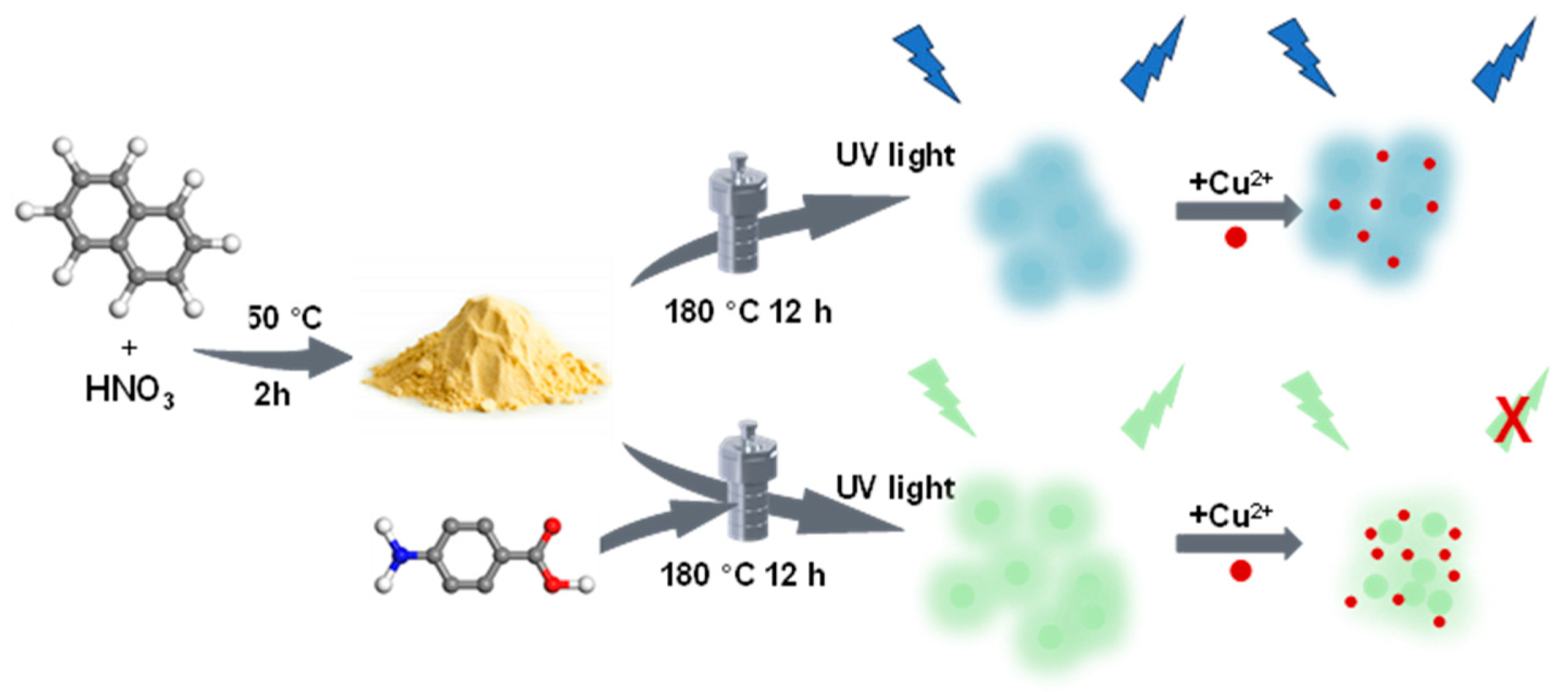
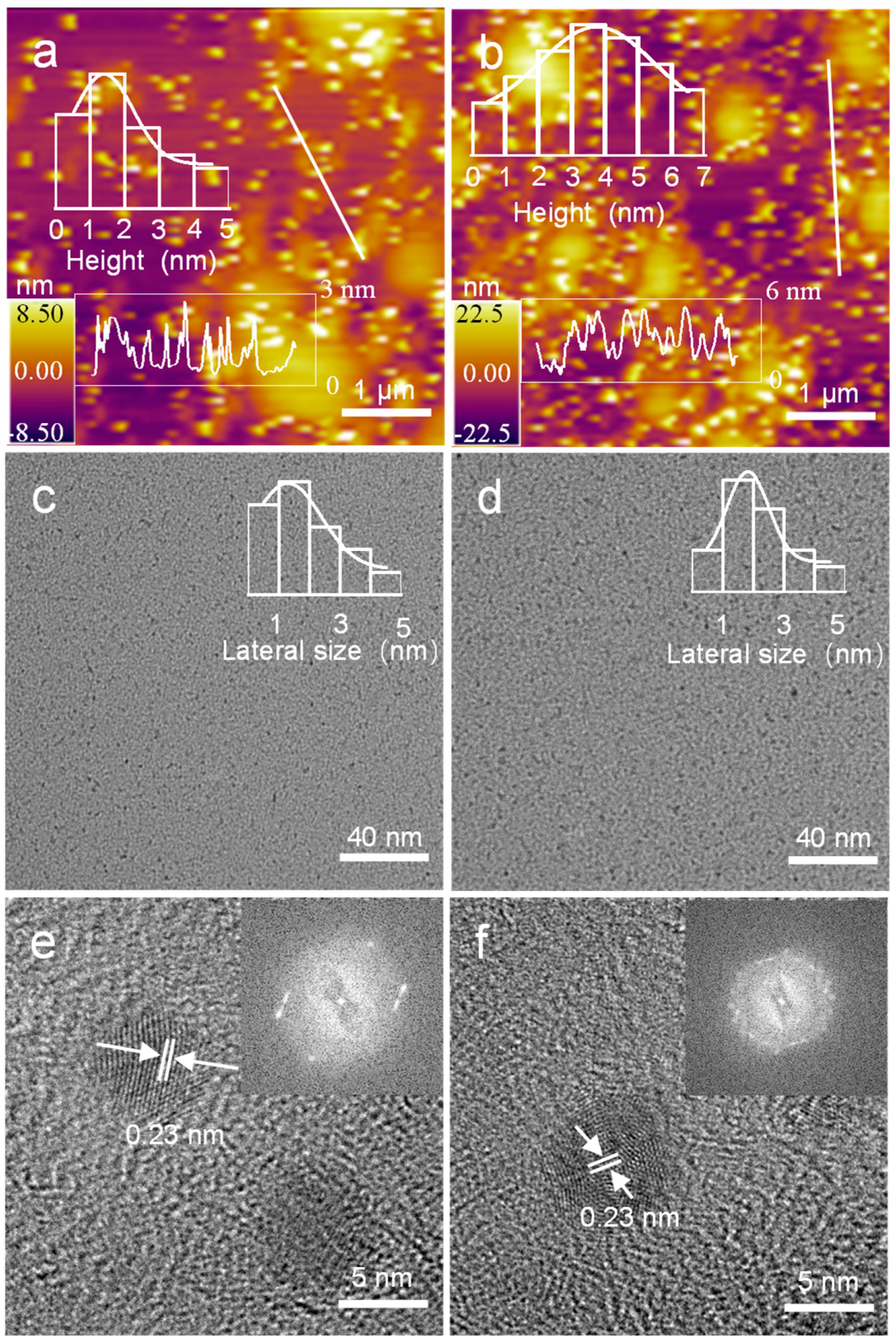
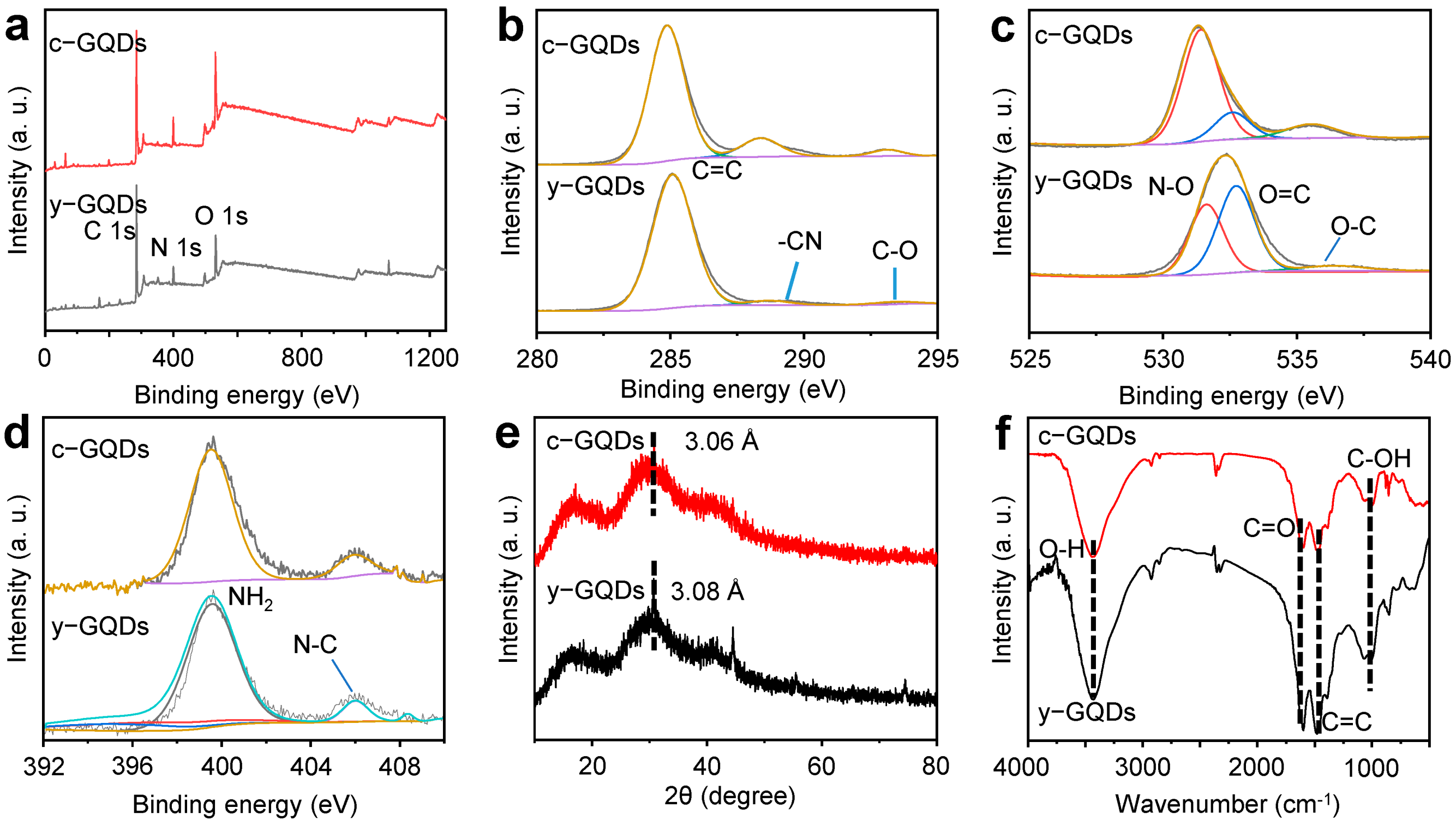

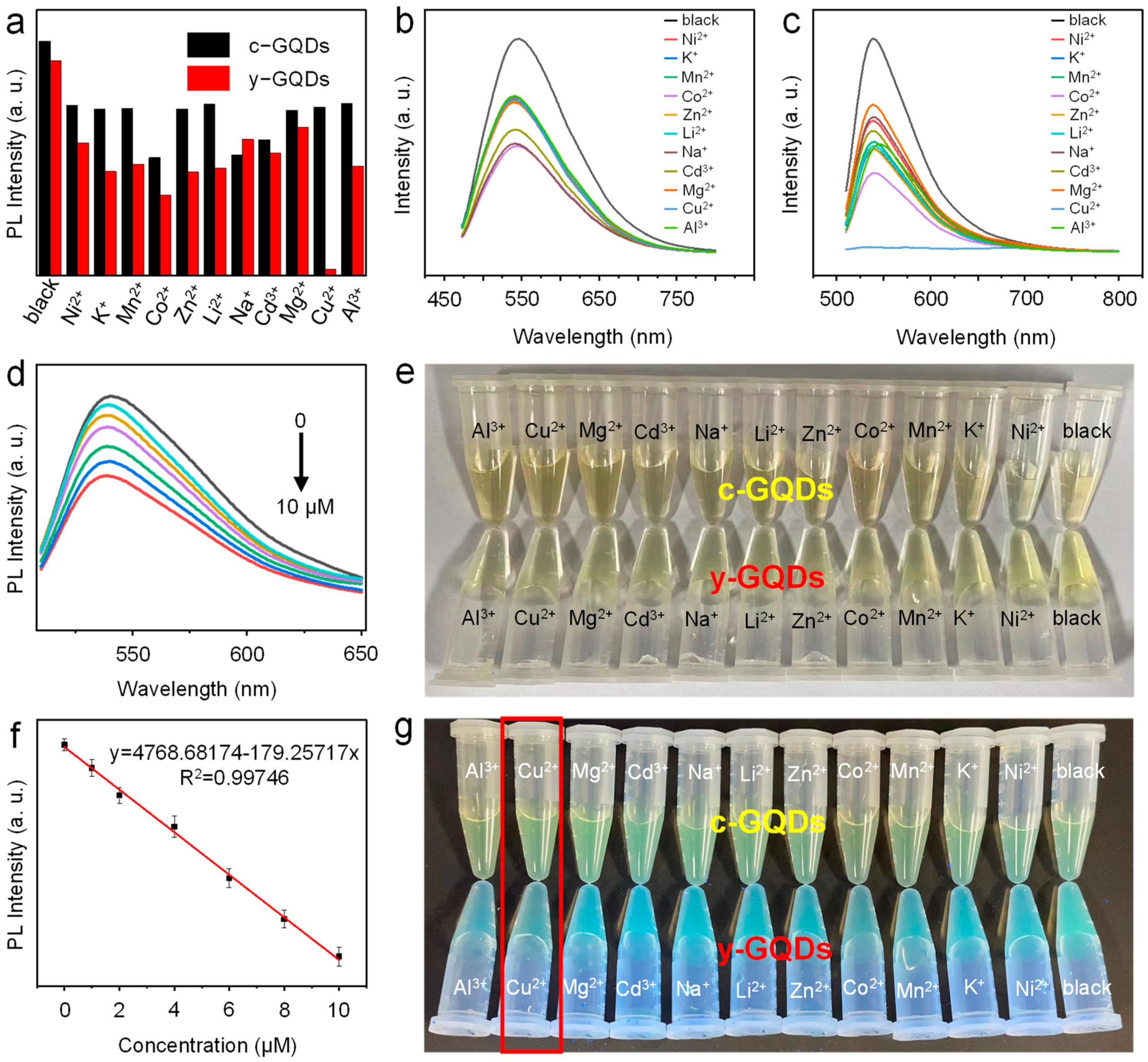
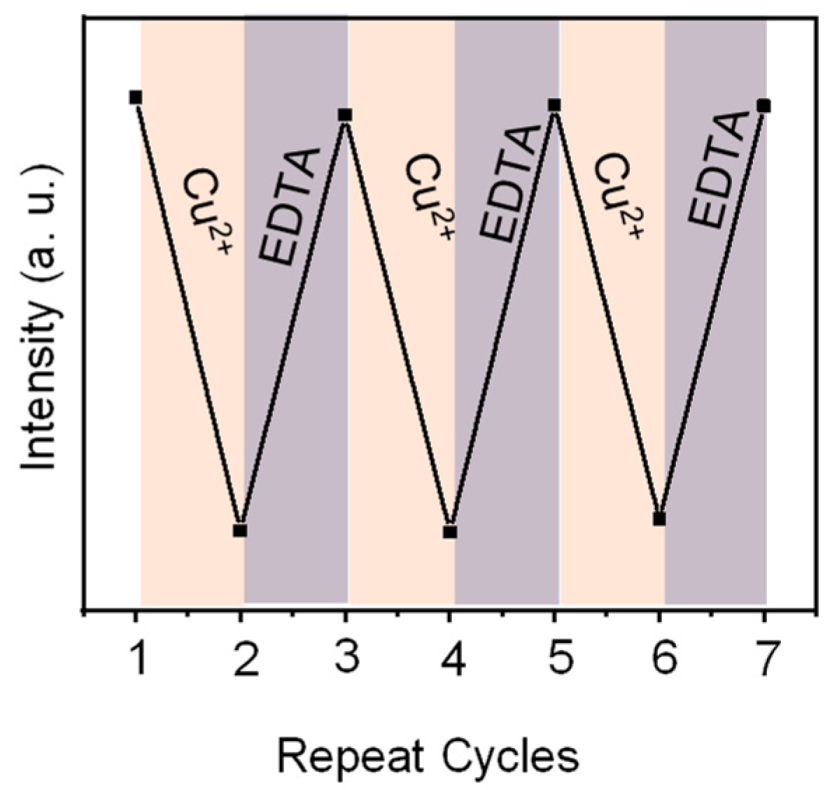
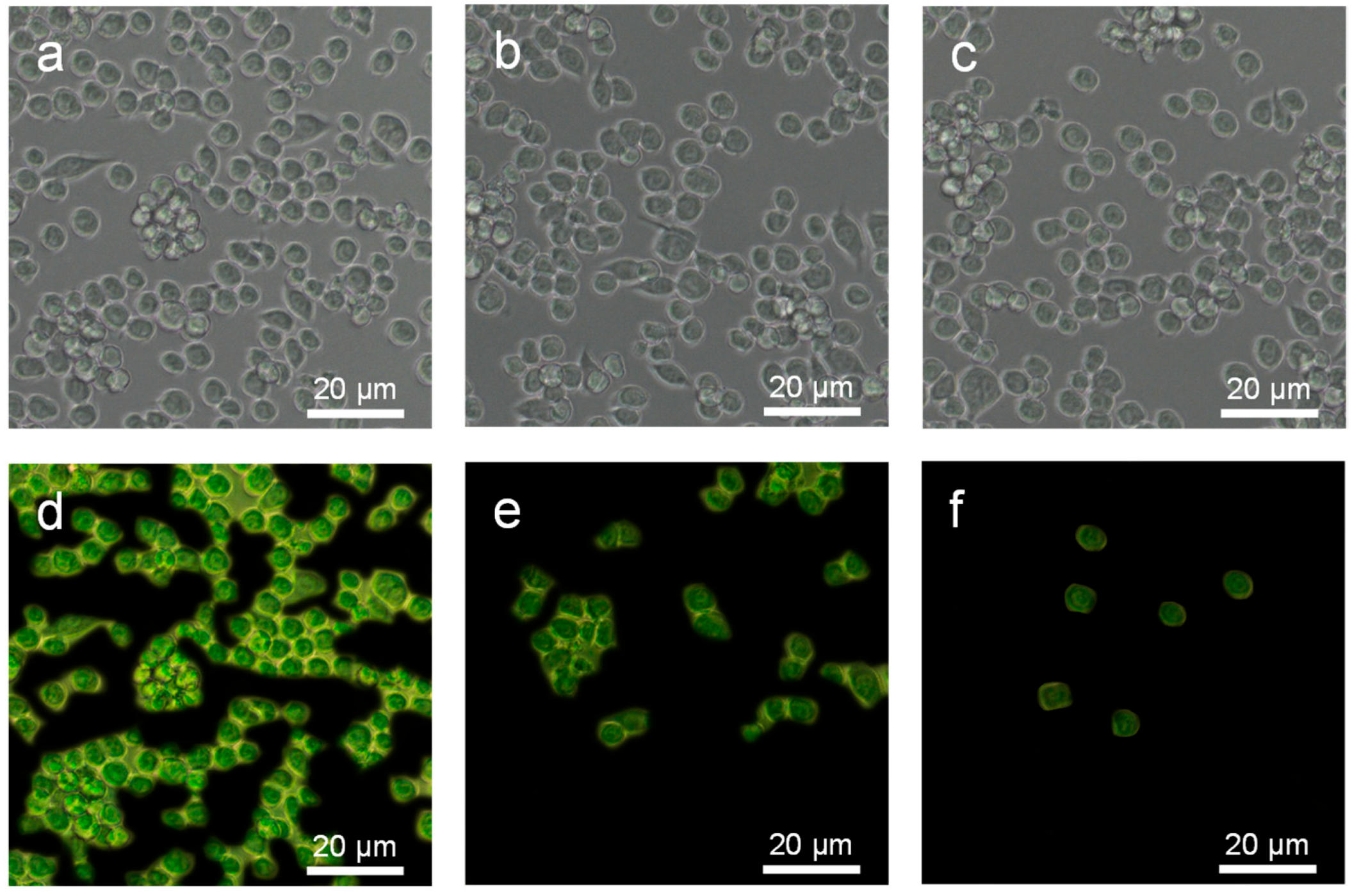
Disclaimer/Publisher’s Note: The statements, opinions and data contained in all publications are solely those of the individual author(s) and contributor(s) and not of MDPI and/or the editor(s). MDPI and/or the editor(s) disclaim responsibility for any injury to people or property resulting from any ideas, methods, instructions or products referred to in the content. |
© 2025 by the authors. Licensee MDPI, Basel, Switzerland. This article is an open access article distributed under the terms and conditions of the Creative Commons Attribution (CC BY) license (https://creativecommons.org/licenses/by/4.0/).
Share and Cite
Li, W.; Niu, Q.; Pang, X.; Li, S.; Liu, Y.; Li, B.; Li, S.; Wang, L.; Guo, H.; Wang, L. Optimized Sensitivity in Copper(II) Ion Detection: Sustainable Fabrication of Fluorescence Red-Shifted Graphene Quantum Dots via Electron-Withdrawing Modulation. Molecules 2025, 30, 1244. https://doi.org/10.3390/molecules30061244
Li W, Niu Q, Pang X, Li S, Liu Y, Li B, Li S, Wang L, Guo H, Wang L. Optimized Sensitivity in Copper(II) Ion Detection: Sustainable Fabrication of Fluorescence Red-Shifted Graphene Quantum Dots via Electron-Withdrawing Modulation. Molecules. 2025; 30(6):1244. https://doi.org/10.3390/molecules30061244
Chicago/Turabian StyleLi, Weitao, Qian Niu, Xinglong Pang, Shang Li, Yang Liu, Boyu Li, Shuangyan Li, Lei Wang, Huazhang Guo, and Liang Wang. 2025. "Optimized Sensitivity in Copper(II) Ion Detection: Sustainable Fabrication of Fluorescence Red-Shifted Graphene Quantum Dots via Electron-Withdrawing Modulation" Molecules 30, no. 6: 1244. https://doi.org/10.3390/molecules30061244
APA StyleLi, W., Niu, Q., Pang, X., Li, S., Liu, Y., Li, B., Li, S., Wang, L., Guo, H., & Wang, L. (2025). Optimized Sensitivity in Copper(II) Ion Detection: Sustainable Fabrication of Fluorescence Red-Shifted Graphene Quantum Dots via Electron-Withdrawing Modulation. Molecules, 30(6), 1244. https://doi.org/10.3390/molecules30061244






